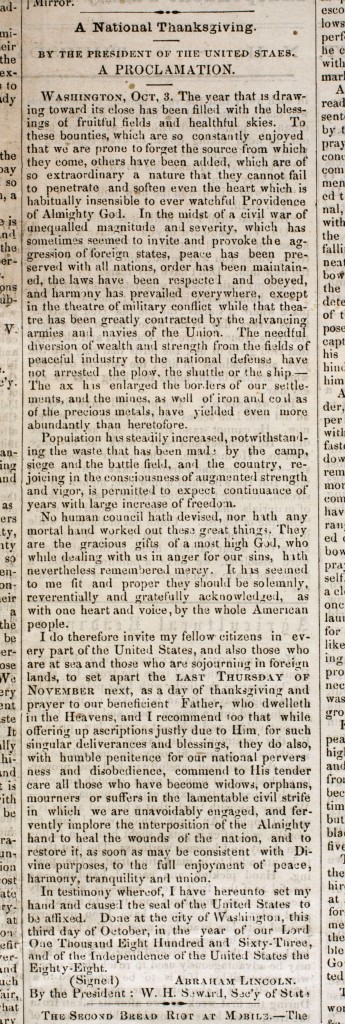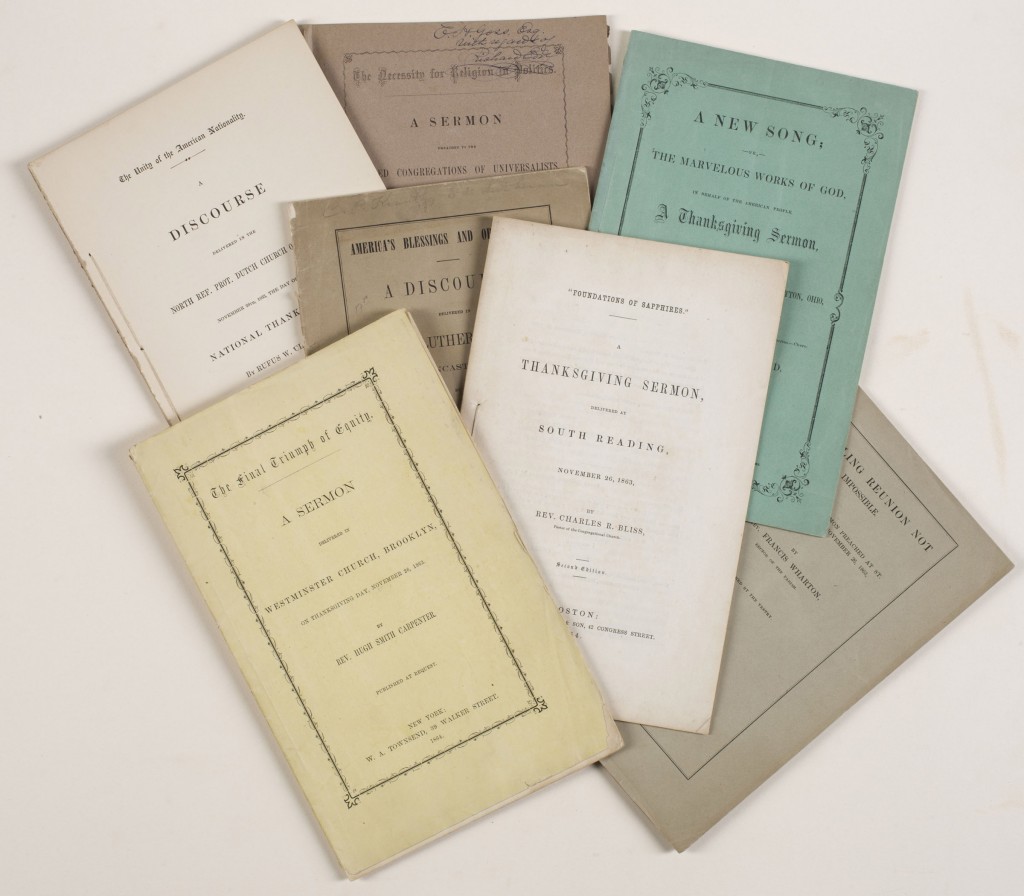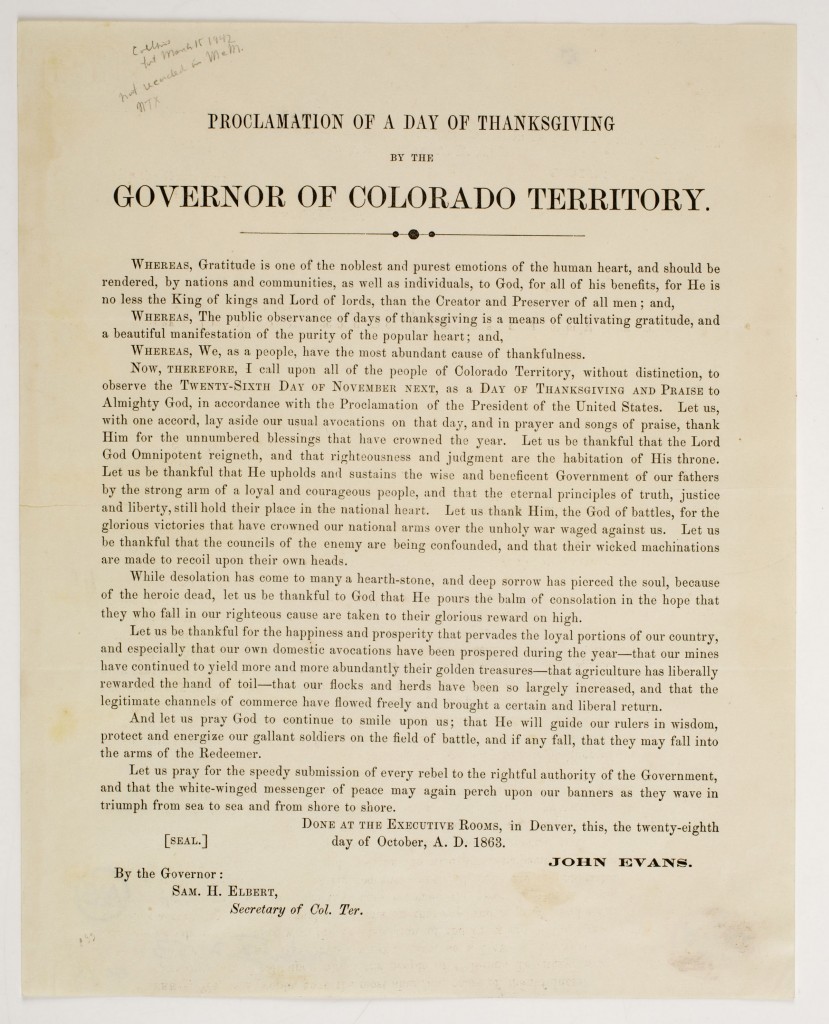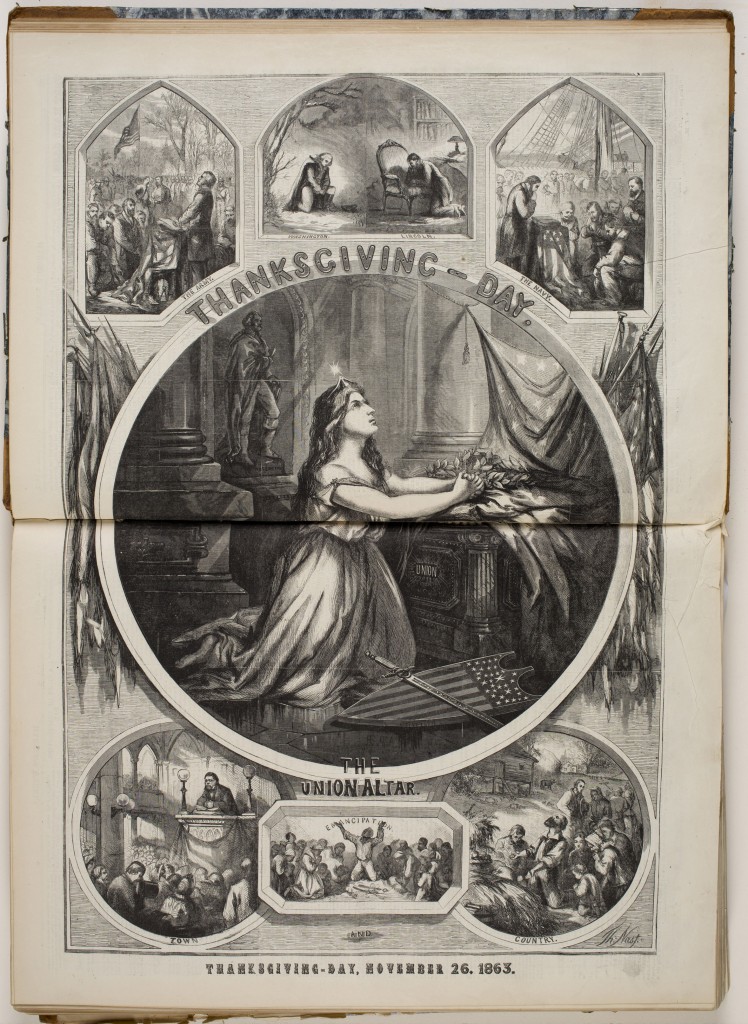 It has been a big year for some of the country’s most important documents. January saw the sesquicentennial of the Emancipation Proclamation, and just last week was the 150th anniversary of the reading of the Gettysburg Address. This Thursday in the United States we celebrate our national day of Thanksgiving, and so are looking back, once again, to 1863, when countless Union newspapers printed President Abraham Lincoln’s Proclamation for “a day of thanksgiving and praise to our beneficial Father” on November 26. Each year since, the sitting president has formally proclaimed that Thanksgiving Day should be celebrated on the last Thursday of November (this changed in 1939 when President Franklin D. Roosevelt set it one week earlier; two years later it was ruled by Congress to be observed as a legal federal holiday on the fourth Thursday in November). In President Lincoln’s Proclamation he states, “it has seemed to me fit and proper they [the bounties of the United States] should be solemnly, reverentially and gratefully acknowledged, as with one heart and voice, by the whole American people.” This proclamation appeared in many publications, including post-observance mentions in some Confederate newspapers. The copy seen to the left is from the October 8, 1863 issue of the Amherst, New Hampshire, Farmer’s Cabinet.
It has been a big year for some of the country’s most important documents. January saw the sesquicentennial of the Emancipation Proclamation, and just last week was the 150th anniversary of the reading of the Gettysburg Address. This Thursday in the United States we celebrate our national day of Thanksgiving, and so are looking back, once again, to 1863, when countless Union newspapers printed President Abraham Lincoln’s Proclamation for “a day of thanksgiving and praise to our beneficial Father” on November 26. Each year since, the sitting president has formally proclaimed that Thanksgiving Day should be celebrated on the last Thursday of November (this changed in 1939 when President Franklin D. Roosevelt set it one week earlier; two years later it was ruled by Congress to be observed as a legal federal holiday on the fourth Thursday in November). In President Lincoln’s Proclamation he states, “it has seemed to me fit and proper they [the bounties of the United States] should be solemnly, reverentially and gratefully acknowledged, as with one heart and voice, by the whole American people.” This proclamation appeared in many publications, including post-observance mentions in some Confederate newspapers. The copy seen to the left is from the October 8, 1863 issue of the Amherst, New Hampshire, Farmer’s Cabinet.
Lincoln’s edict was met with support from Union state governors’ offices. In AAS’s collection are several broadsides endorsing a national day of Thanksgiving, including from New England states Massachusetts, Connecticut, and New Hampshire, but also this featured example from the Colorado Territory (see below), which closes with a prayer that “the white-winged messenger of peace may again perch upon our banners as they wave in triumph from sea to sea and from shore to shore.”
By the time of Lincoln’s Proclamation, Thanksgiving practices had their own history spanning Colonial and Revolutionary America, and it was an issue frequently brought to the surface by states observing a yearly Thanksgiving holiday. This is in addition to Sarah Josepha Hale, long-time editor of the popular Godey’s Lady’s Book, promoting the idea of a national thanksgiving. Her editorial in September 1863, “Our National Thanksgiving,” provides the recipe for such a holiday, tying it closely to the war effort – she closes, “A national feeling of Thanksgiving, putting the beauty, goodness and love of the Creator before the eyes of the dullest and the hearts of the coldest, would effect incalculable benefits to our Country.”
 Items in the Society stemming from this day are not just limited to those created by people in executive positions, however. For example, contained within the collections is also an assortment of pamphlets and transcribed sermons reflecting numerous religious denominations, places, and subjects. This assortment includes titles such as America’s Blessings and Obligations, A Willing Reunion Not Impossible, and The Necessity for Religion in Politics.
Items in the Society stemming from this day are not just limited to those created by people in executive positions, however. For example, contained within the collections is also an assortment of pamphlets and transcribed sermons reflecting numerous religious denominations, places, and subjects. This assortment includes titles such as America’s Blessings and Obligations, A Willing Reunion Not Impossible, and The Necessity for Religion in Politics.
The print culture of Thanksgiving 1863 is understandably more somber than images of Pilgrims and turkeys. This includes a double-page wood engraving by Thomas Nast (1840-1902) in the December 5, 1863 issue of Harper’s Weekly (below). In this image, a central illustration of Columbia is seen kneeling at the Union Altar which is draped with the American flag. Six scenes of Thanksgiving prayer – the Union Army, kneeling Presidents George Washington and Abraham Lincoln, the Navy, farmers in the country, residents gathered in a Town Hall, and emancipated slaves – surround the dominant allegorical figure.
So is Thanksgiving a day of food and feasting? Absolutely. It is also one that has evolved from the New England fall festivals into joyous reunions and big dinners. But during the years of the Civil War, especially 1863, it grew into one of observance, serious moral and religious thinking, church services, and prayer. In an attempt to answer one the earliest appeals for its establishment as a national holiday, Lincoln shaped it into one about the widows, orphans, mourners, and others suffering from the war.


